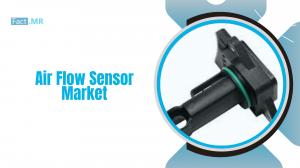Air Flow Sensor Market to Hit USD 3,398 Million by 2035, Registering a CAGR of 3.6%
Analysis of Air Flow Sensor Market Covering 30+ Countries Including Analysis of US, Canada, UK, Germany, France, Nordics, GCC countries, Japan, Korea and many
MD, UNITED STATES, July 4, 2025 /EINPresswire.com/ -- The global airflow sensor market is forecasted to reach USD 3,398 million in 2035, up from an estimated USD 2,386 million in 2025. During the forecast period of 2025 to 2035, the market is expected to grow with a CAGR of 3.6%. leading market research and competitive intelligence provider, has released a comprehensive report on the Global Air Flow Sensors Market, projecting remarkable growth driven by increasing demand for energy-efficient solutions and advanced automotive technologies. The report highlights that the global air flow sensors market is set to expand significantly over the coming years, supported by technological advancements and widening applications across diverse industries.Air flow sensors, essential components in modern systems, are playing a pivotal role in improving process efficiency, optimizing air-fuel ratios in engines, and enhancing environmental monitoring. The newly published report offers in-depth analysis on market dynamics, key growth drivers, challenges, recent innovations, and the competitive landscape, providing valuable insights for stakeholders and decision-makers.
For More Insights into the Market, Request a Sample of this Report: https://www.factmr.com/connectus/sample?flag=S&rep_id=1259
Growing Emphasis on Energy Efficiency and Emission Reduction Fuels Market Expansion:
The Fact.MR report indicates that the air flow sensors market is witnessing strong traction as industries prioritize sustainability, precision, and system optimization. Automotive manufacturers are increasingly integrating air flow sensors to enhance fuel efficiency, reduce carbon emissions, and comply with stringent environmental regulations. These sensors are crucial in maintaining optimal engine performance by accurately measuring the air intake.
Market Trends, Growth Drivers, Challenges, and Competitive Landscape:
Several key factors are driving the growth of the air flow sensors market. The automotive sector remains the dominant end-user, with air flow sensors playing a crucial role in combustion engines, turbochargers, and exhaust gas recirculation systems to optimize air-fuel ratios and enhance vehicle performance. The medical device industry is also seeing rising adoption of these sensors, driven by the need for accurate respiratory monitoring, increased focus on patient safety, and the growing prevalence of chronic respiratory conditions. Additionally, the expansion of industrial automation and HVAC systems is boosting demand, as air flow sensors are essential for maintaining controlled environments, improving energy efficiency, and ensuring system reliability. Technological advancements, particularly the development of MEMS-based air flow sensors, are further propelling market growth by offering better sensitivity, compact designs, and cost efficiency. Moreover, tightening global environmental regulations are pushing automotive and industrial players to adopt advanced air monitoring solutions, reinforcing the need for high-precision air flow sensors across multiple industries.
Competitive Landscape:
The air flow sensors market is moderately fragmented, with both established players and emerging companies vying for market share. Companies are focusing on product innovation, strategic partnerships, and capacity expansion to strengthen their global footprint.
Industry News: A Dynamic and Evolving Market:
The air flow sensors market is experiencing strong growth across key sectors. In the automotive industry, companies like Bosch and Denso are advancing sensor technologies to meet stricter emissions standards and support electric vehicle development. The medical sector is also expanding, with TE Connectivity and Honeywell introducing compact, low-power sensors for portable ventilators and respiratory devices. Additionally, Siemens and Sensirion are enhancing HVAC systems with smart air flow sensors for improved air quality and energy efficiency in modern buildings.
Industry Applications: Unlocking Multi-Sectoral Benefits:
The Fact.MR report highlights the broad and versatile applications of air flow sensors across multiple industries. In the automotive sector, these sensors play a key role in measuring engine air intake, turbocharger efficiency, and exhaust emissions, supporting better fuel economy and lower environmental impact. In healthcare, air flow sensors are critical components in medical ventilators, anesthesia machines, and spirometers, ensuring precise patient monitoring and effective treatment. Industrial applications include HVAC systems, cleanrooms, and process control, where air flow sensors help maintain safety and energy efficiency. In consumer electronics, these sensors are integrated into air purifiers, smart ventilation systems, and personal respiratory devices to improve air quality management. The aerospace industry also relies on air flow sensors for cabin ventilation, air management, and fuel optimization to enhance aircraft safety and performance. Across all these sectors, air flow sensors contribute to greater precision, higher system reliability, and reduced operational costs.
Key Players in the Air Flow Sensors Market
The report profiles several key players shaping the competitive landscape of the air flow sensors market. These include:
Denso Corporation
Sensata Technologies
Robert Bosch GmbH
Honeywell International Inc.
TE Connectivity Ltd.
Siemens AG
Sensirion AG
First Sensor AG
Analog Devices, Inc.
Continental AG
Get Customization on this Report for Specific Research Solutions-https://www.factmr.com/connectus/sample?flag=S&rep_id=1259
Recent developments in the air flow sensors market highlight a shift towards advanced, energy-efficient, and connected solutions. Bosch launched a compact MEMS-based sensor to enhance vehicle fuel economy, while TE Connectivity introduced low differential pressure sensors for medical and HVAC use. Sensirion AG unveiled a digital sensor optimized for portable respiratory devices, and Denso partnered with a top automaker to develop air flow sensors for electric and hybrid vehicles. Additionally, Siemens expanded its HVAC sensor range with IoT-enabled models for smart building air quality monitoring.
Explore More Related Studies Published by Fact.MR Research:
The global fire alarm and detection market will grow steadily throughout the years from 2025 to 2035 at a 6% CAGR. The industry valuation for 2025 is expected to achieve USD 33.56 billion before reaching USD 60.10 billion by 2035.
The global food waste recycling machine market is anticipated to become USD 3.1 billion in 2025 and reach USD 5.87 billion by 2035, with a constant CAGR growth of 6.6%,
About Fact.MR:
We are a trusted research partner of 80% of fortune 1000 companies across the globe. We are consistently growing in the field of market research with more than 1000 reports published every year. The dedicated team of 400-plus analysts and consultants is committed to achieving the utmost level of our client’s satisfaction.
Contact:
11140 Rockville Pike
Suite 400
Rockville, MD 20852
United States
Tel: +1 (628) 251-1583
Sales Team: sales@factmr.com
Follow Us: LinkedIn | Twitter | Blog
S. N. Jha
Fact.MR
+1 628-251-1583
email us here
Legal Disclaimer:
EIN Presswire provides this news content "as is" without warranty of any kind. We do not accept any responsibility or liability for the accuracy, content, images, videos, licenses, completeness, legality, or reliability of the information contained in this article. If you have any complaints or copyright issues related to this article, kindly contact the author above.
Right Hand Technology Group Ranks Among Top 100 MSPs Worldwide in 2025
Upstream Activity Drives OCTG Market to $37.5 Billion by 2030
Catecholamines Market Forecast To 2034 – For Business Leaders, Analysts, And Strategic Teams
Więcej ważnych informacji
 Jedynka Newserii
Jedynka Newserii

 Jedynka Newserii
Jedynka Newserii

Bankowość

Rośnie liczba i wartość udzielonych konsumentom kredytów gotówkowych. Gorzej mają się kredyty ratalne oraz te udzielane firmom
Rynek kredytowy w Polsce co do zasady rośnie, choć nierównomiernie. Z danych Biura Informacji Kredytowej wynika, że najlepiej rozwija się segment kredytów gotówkowych dla konsumentów. Wartościowo wzrosła też kwota udzielonych limitów w kartach kredytowych. Według prognoz BIK w całym roku wzrośnie wartość zarówno udzielonych kredytów mieszkaniowych, jak i gotówkowych, choć tych pierwszych poniżej inflacji. Wcześniejsze cięcia stóp procentowych przez RPP nie zmieniły tej prognozy.
Transport
37,5 proc. środków z Planu Społeczno-Klimatycznego trafi na walkę z ubóstwem transportowym. Organizacje branżowe apelują o zmianę priorytetowych projektów [DEPESZA]

Ministerstwo Funduszy i Polityki Regionalnej z końcem czerwca zakończyło konsultacje Planu Społeczno-Klimatycznego, który otwiera drogę do pozyskania 65 mld zł (11,4 mld euro) z unijnego Społecznego Funduszu Klimatycznego. Polska będzie jego największym beneficjentem, a 37,5 proc. budżetu zostanie przeznaczone na bezpośrednie wsparcie osób narażonych na ubóstwo transportowe. Organizacje branżowe oceniają jednak, że walka z tym zjawiskiem może się okazać nieskuteczna. W toku konsultacji zgłosiły swoje zastrzeżenia co do priorytetów w wydatkach i sposobu wsparcia inwestycji w transport rowerowy.
Prawo
Firmy będą mogły przetestować krótszy tydzień pracy z rządowym wsparciem. Nabór wniosków ruszy w sierpniu

Ministerstwo Rodziny, Pracy i Polityki Społecznej uruchamia pilotaż krótszego tygodnia pracy. Zainteresowane wzięciem w nim udziału firmy będą się mogły ubiegać o wsparcie finansowe ze strony rządu. Politycy Nowej Lewicy, którzy są pomysłodawcami testu tego rozwiązania, przekonują, że finalnie zyskają na nim wszyscy, zarówno pracownicy, jak i pracodawcy, a ostrzeżenia o spodziewanych problemach gospodarki są mocno przesadzone.
Partner serwisu
Szkolenia

Akademia Newserii
Akademia Newserii to projekt, w ramach którego najlepsi polscy dziennikarze biznesowi, giełdowi oraz lifestylowi, a także szkoleniowcy z wieloletnim doświadczeniem dzielą się swoją wiedzą nt. pracy z mediami.

![37,5 proc. środków z Planu Społeczno-Klimatycznego trafi na walkę z ubóstwem transportowym. Organizacje branżowe apelują o zmianę priorytetowych projektów [DEPESZA]](https://www.newseria.pl/files/1097841585/rower3,w_85,_small.jpg)







.gif)

 |
| |
| |
|